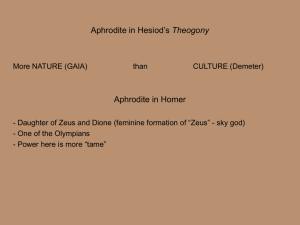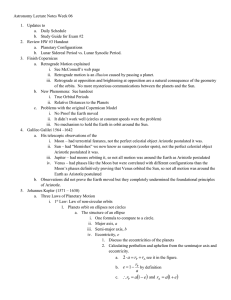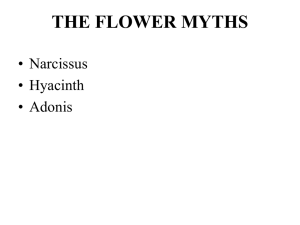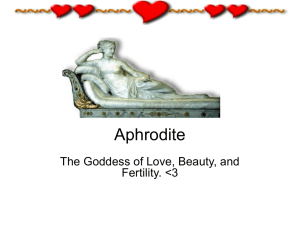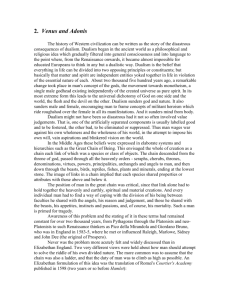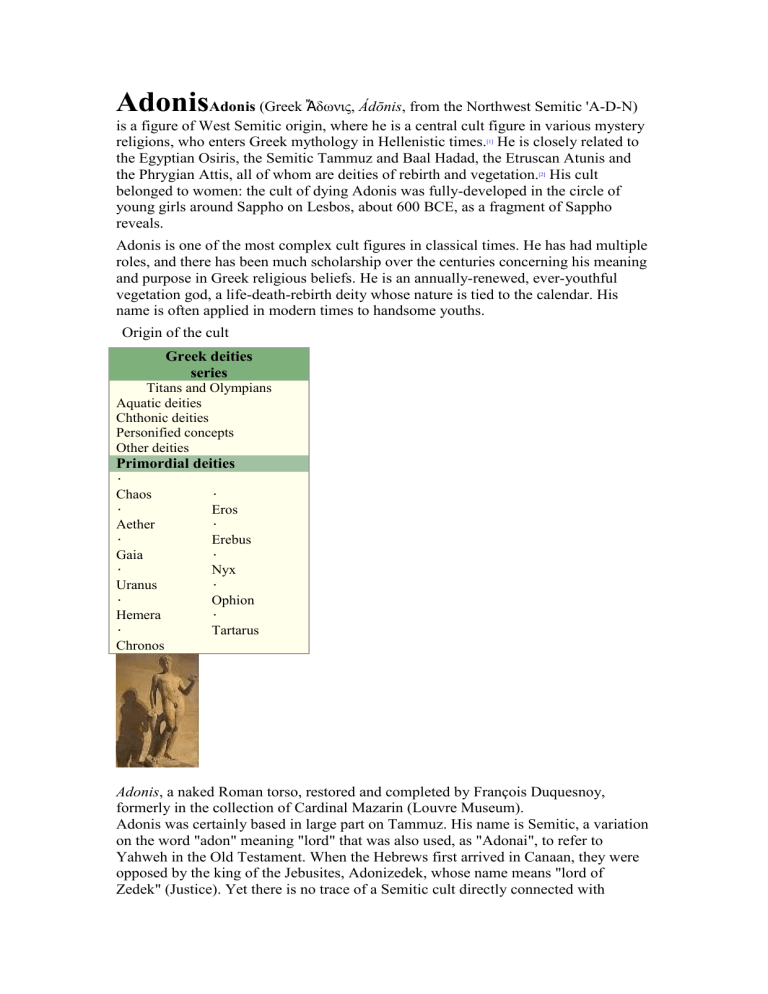
AdonisAdonis (Greek Ἄδωνις, Ádōnis, from the Northwest Semitic 'A-D-N) is a figure of West Semitic origin, where he is a central cult figure in various mystery religions, who enters Greek mythology in Hellenistic times. He is closely related to the Egyptian Osiris, the Semitic Tammuz and Baal Hadad, the Etruscan Atunis and the Phrygian Attis, all of whom are deities of rebirth and vegetation. His cult belonged to women: the cult of dying Adonis was fully-developed in the circle of young girls around Sappho on Lesbos, about 600 BCE, as a fragment of Sappho reveals. [1] [2] Adonis is one of the most complex cult figures in classical times. He has had multiple roles, and there has been much scholarship over the centuries concerning his meaning and purpose in Greek religious beliefs. He is an annually-renewed, ever-youthful vegetation god, a life-death-rebirth deity whose nature is tied to the calendar. His name is often applied in modern times to handsome youths. Origin of the cult Greek deities series Titans and Olympians Aquatic deities Chthonic deities Personified concepts Other deities Primordial deities • Chaos • • Eros Aether • • Erebus Gaia • • Nyx Uranus • • Ophion Hemera • • Tartarus Chronos Adonis, a naked Roman torso, restored and completed by François Duquesnoy, formerly in the collection of Cardinal Mazarin (Louvre Museum). Adonis was certainly based in large part on Tammuz. His name is Semitic, a variation on the word "adon" meaning "lord" that was also used, as "Adonai", to refer to Yahweh in the Old Testament. When the Hebrews first arrived in Canaan, they were opposed by the king of the Jebusites, Adonizedek, whose name means "lord of Zedek" (Justice). Yet there is no trace of a Semitic cult directly connected with Adonis, and no trace in Semitic languages of any specific mythemes connected with his Greek myth; both Greek and Near Eastern scholars have questioned the connection (Burkert, p 177 note 6 bibliography). The connection in cult practice is with Adonis' Mesopotamian counterpart, Tammuz: "Women sit by the gate weeping for Tammuz, or they offer incense to Baal on roof-tops and plant pleasant plants. These are the very features of the Adonis cult: a cult confined to women which is celebrated on flat roof-tops on which sherds sown with quickly germinating green salading are placed, Adonis gardens... the climax is loud lamentation for the dead god." —Burkert, p. 177. When the cult of Adonis was incorporated into Greek culture is debated: Hesiod made him the son of Phoinix, eponym of the Phoenicians, and his association with Cyprus is not attested before the classical era. W. Atallah suggests that the later Hellenistic myth of Adonis represents the conflation of two independent traditions. [3] Adonis was worshipped in unspoken mystery religions: not until Imperial Roman times (in Lucian of Samosata, De Dea Syria, ch. 6 [1]) does any written source mention that the women were consoled by a revived Adonis. The third century BCE poet Euphorion of Chalcis in his Hyacinth wrote "Only Cocytus washed the wounds of Adonis". Women in Athens would plant "gardens of Adonis" quick-growing herbs that sprang up from seed and died. The Festival of Adonis was celebrated by women at midsummer by sowing fennel and lettuce, and grains of wheat and barley. The plants sprang up soon, and withered quickly, and women mourned for the untimely death of the vegetation god (Detienne 1972). [4] [edit] Birth and death of Adonis Aphrodite and Adonis, Attic red-figure aryballos-shaped lekythos by Aison, ca. 410 BC, Louvre. Adonis' birth is shrouded in confusion for those who require a single, authoritative version. The patriarchal Hellenes sought a father for the god, and found him in Byblos and Cyprus, which scholars take to indicate the direction from which Adonis' cult had come to the Greeks. Pseudo-Apollodorus, (Bibliotheke, 3.182) considered Adonis to be the son of Cinyras, of Paphos on Cyprus, and Metharme. Hesiod, in a fragment, believes he is the son of Phoenix and Aephesiboea. In Cyprus, the cult of Adonis gradually superseded the cult of Cinyras . Walter Burkert questions whether Adonis had not from the very beginning come to Greece with Aphrodite (Burkert 1985, p. 177) [5] The Death of Adonis, by Giuseppe Mazzuoli, 1709 (Hermitage Museum). Multiple versions of the birth of Adonis exist: The most commonly accepted version is that Aphrodite urged Myrrha to commit incest with her father, Theias, the King of Smyrna or Syria (which helps confirm the area of Adonis' origins). Myrrha's nurse helped with the scheme, and Myrrha coupled with her father in the darkness. When Theias at last discovered this deception by means of an oil lamp, he flew into a rage, chasing his daughter with a knife. Myrrha fled from her father, and Aphrodite turned her into a myrrh tree. When Theias shot an arrow into the tree — or alternately when a boar used its tusks to rend the tree's bark — Adonis was born from the tree. This myth fits both Adonis' nature as a vegetation god and his origins from the hot foreign desert lands where the myrrh tree grew. (It was not to be seen in Greece.) As soon as Adonis was born. the baby was so beautiful that Aphrodite placed him in a closed chest, which she delivered for security to Persephone, who was also entranced by his unearthly beauty and refused to give him back. The argument between the goddess of love and the goddess of death was settled by Zeus, with Adonis spending six months with Aphrodite, who seduced him with the help of Helene, her friend, and six months with Persephone. [6] Adonis died at the tusks of a wild boar, sent by either Artemis in retaliation for Aphrodite instigating the death of Hippolytus, a favorite of the huntress goddess, or Aphrodite's paramour, Ares. As Aphrodite sprinkled nectar on his body, each drop of Adonis' blood turned into a blood-red anemone, and the river Adonis (modern Nahr Ibrahim) flowing out of Mount Lebanon in coastal Lebanon ran red, according to Lucian (chs. 6 – 9). Therefore, Persephone ultimately laid claim to Adonis as his shade was transported forever more to the Underworld. Lucian, who attributes the color of the river Adonis to siltation, adds "Nonetheless, there are some inhabitants of Byblos who say that Osiris of Egypt lies buried among them, and the mourning and the ceremonies are all made in honor of Osiris instead of Adon" [2]. Certainly there are many parallels with the myth of Osiris, encased in the coffin, imprisoned in the tree from which he issues forth. [7] "In Greece" Burkert concludes, "the special function of the Adonis cult is as an opportunity for the unbridled expression of emotion in the strictly circumscribed life of women, in contrast to the rigid order of polis and family with the official women's festivals in honour of Demeter." The most detailed and literary version of the story of Adonis is in Book X of Ovid's Metamorphoses. [edit] Modern metaphorical use of the name Death of Adonis, by Luca Giordano. In modern parlance the name "Adonis" is frequently used as an allusion to an extremely attractive, youthful male, often with a connotation of deserved vanity: "the office Adonis". In Arthur Miller's Death of a Salesman, Willy Loman refers to his sons Biff and Happy as "Adonises." This is representative of the idealistic way he views them. Giovan Battista Marino's masterpiece, Adone, published in 1623, is a long, sensual poem, which elaborates the myth of Adonis, and represents the transition in Italian literature from Mannerism to the Baroque. Percy Bysshe Shelley wrote the poem Adonais for John Keats, and uses the myth as an extended metaphor for Keats' death. A 19th-century reproduction of a Greek bronze of Adonis found at Pompeii. Sarrasine by Honore de Balzac, is about a painting of an Adonis and a castrato, who the main character, Sarrasine, falls in love with. Adunis (an Arabic transliteration of the same name, )أدون يسis the nom de plume of a famous Syrian poet, Ali Ahmad Said Asbar, who was nominated more than once for a Nobel Prize for literature, including in 2006. His choice of name relates especially to the rebirth element of the myth of Adonis (also called "Tammuz" in Arabic), which was an important theme in mid-20th century Arabic poetry, chiefly amongst followers of the "Free Verse" ( )ال حر ال ش عرmovement founded by Iraqi poet Badr Shakir al-Sayyab. Adunis has used the myth of his namesake in many of his poems, for example in "Wave I", from his most recent book "Start of the Body, End of the Sea" (Saqi, 2002), which includes a complete retelling of the birth of the god. An Adonis Complex refers to a psychological obsession with improving one's physique and youthful appearance: see body image In the Disney adaption of The Hunchback of Notre Dame, one of the musical numbers, A Guy Like You, involves the lines; We all have gaped at some Adonis But then we crave a meal more nourishing to chew And since you're shaped like a croissant is No question of, she's gotta love A Guy Like You. This is comparing Quasimodo's hunched form to that of an 'Adonis. In The Simpsons season 2 episode, "Brush With Greatness", Marge's teacher picks her painting of Homer to show at a gallery and says "I would like to show your bald Adonis." In Twilight, Bella Swan often refers to her vampire boyfriend, Edward Cullen, as her marble carved Adonis. In the anime version of DNAngel (episode 7) an Adonis statue is recovered. The statue then comes to life and attempts to lure in young girls so as to eat their souls. At some point in the episode, the Adonis spirit takes a young girl to a Dracula movie as well. Foreshadowing his own intentions. And at the end of the episode he does become something like a vampire.

